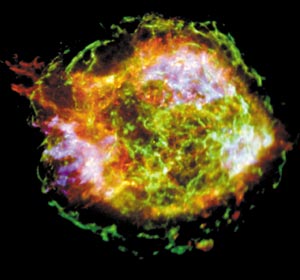
The discoveries of three new extrasolar planets were recently announced within the space of a week. With masses around or less than 20 times that of the Earth, these new exoplanets are the lightest known so far. After Jupiter- and Saturn-like extrasolar planets, the detection of these Neptune- and Uranus-sized objects represents an important step in the quest for exoplanets similar to Earth.
Following the discovery in 1995 of the first extrasolar planet, and fuelled by its enormous impact on the general public, the hunt for exoplanets has already led to the discovery of about 130 planets around nearby stars. Two groups on either side of the Atlantic are leading the race. The European group discovered the very first exoplanet around the star 51 Pegasi and was also the first to announce the discovery of a lightweight planet on 25 August this year. The American group, which has discovered about half of all known exoplanets, responded only one week later by announcing their discovery of two Neptune-sized planets.
The presence of a planet orbiting a star is revealed by its gravitational pull making the star wobble around the centre of mass of the system. The wobbling can be detected in a sequence of radial velocity measurements using high-resolution spectra of the star. This method allows the orbit of the planet – in particular, the period and the distance from the star – as well as a lower limit for its mass to be deduced. Statistically, the true mass will in most cases be not much higher than this limit.
The most precise instrument for detecting exoplanets is currently the High Accuracy Radial Velocity Planet Searcher, HARPS. Installed a year ago on the 3.6 m telescope of the European Southern Observatory at La Silla, Chile, it is able to measure the wobbling of stars with a precision of about 1 metre per second, or around walking speed.
The three newly discovered exoplanets are all very close to their star. Discovered with HARPS by the European group (Santos et al. 2004), the Uranus-sized planet (14.5 Earth masses) orbiting µ-Arae accomplishes a full revolution of the star in 9.5 days. The two Neptune-sized planets (17 Earth masses) discovered by the American group have even shorter revolution periods of less than three days. One is orbiting a reddish low-mass star called Gliese 436 (Butler et al. 2004), while the other orbiting 55 Cancri is the fourth planet found around this metal-rich star (McArthur et al. 2004). Astronomers can only speculate on the true nature of these lightweight planets. They are most likely made of a rocky core surrounded by a small gaseous envelope.
The hunt to detect smaller and smaller exoplanets is far from over. HARPS is able to find planets down to a few Earth masses, paving the way for space missions such as COROT, Eddington and Kepler, which aim to detect a possible transit of the planet in front of the star. The next step will be the direct imaging of the planets with projects such as ESA’s Darwin interferometric mission or NASA’s Terrestrial Planet Finder. Finding the spectral signature of life in the atmosphere of Earth-like planets will be the ultimate goal of these missions.
Further reading
P Butler et al. 2004 ApJ http://arxiv.org/ abs/astro-ph/0408587.
B E McArthur et al. 2004 ApJ http://arxiv.org/ abs/astro-ph/0408585.
N C Santos et al. 2004 A&A http://arxiv.org/ abs/astro-ph/0408471.
Picture of the month

This spectacular X-ray false-colour image of the supernova remnant Cassiopeia A is the most detailed image ever made of the remains of an exploded star. It is the result of a one-million-second (11.5 day) observation by NASA’s Chandra X-ray observatory. The point source at the centre of the expanding gas bubble, which is 10 light-years wide, is presumed to be a neutron star created during the supernova explosion some 340 years ago. But, unlike the pulsar in the Crab Nebula, this neutron star does not show evidence for pulsed radiation. (Credit: NASA/CXC/GSFC/U Hwang et al.)





